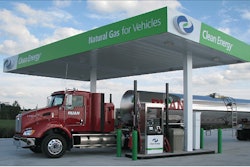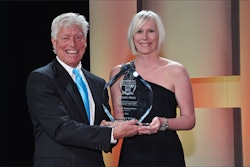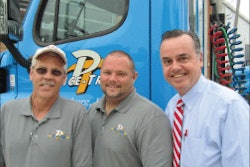Schneider National’s evolving program sets a benchmark for cargo security measures
by Jeff Crissey
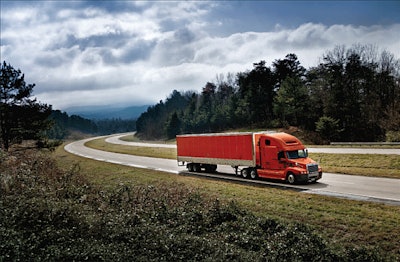
Green Bay, Wis.
Cargo theft is up sharply in the last five years, creating an uneasy feeling for shippers of high-value goods that are most susceptible to theft. For these companies, carrier selection is paramount to lowering their exposure to crime rings and common thieves on the nation’s highways.
For the folks at Schneider National, their services are an easy sell, thanks in large part to a stringent cargo security program that has resulted in a decline in cargo theft at a time when such crime is on the rise and thieves are more selective and aggressive in choosing their targets. In fact, the Green Bay, Wis.-based truckload, intermodal and logistics provider has posted double-digit decreases in cargo theft five years running, including a 35 percent decrease in 2011 – the largest decline in its history.
About face
Until recently, Schneider National – like most carriers – struggled to get a grasp on its cargo security. In 2005 and 2006, Schneider National’s cargo theft incidence rate was on the rise, especially for electronics goods. Company leaders recognized a change was necessary and set out to implement what has evolved into an industry-leading cargo theft prevention program.
Schneider National’s challenge was to identify and anticipate a continuously changing security environment and adapt its load security practices to it. The first steps were hiring a professional security representative, Walt Fountain – who today is the company’s director of loss prevention and enterprise security – and instituting an enterprise security council with representatives from all areas of the business.
The national carrier develops a comprehensive load security program for high-value freight and sharply lowers its cargo theft incidence rate.
“We needed to engage across the whole of our enterprise and bring people together so we could accurately assess our capabilities and develop programs to improve our security,” says Don Osterberg, vice president of safety and driver training.
The end result of Schneider National’s early cargo theft prevention efforts created a new “culture of safety” within the organization. “Every action we take and decision we make is cautiously vetted through a security lens first,” says Osterberg.
Today, Schneider National’s safety culture is defined clearly by three domains: physical security, information security and personnel security.
The company’s physical security efforts involve what most carriers are familiar with – alarms, gate guards, regular load inspections and locking devices – as well as contingency plans and regular exercise drills to ensure procedures are executed properly.
“There are a lot of companies that have intricate security plans that are in a three-ring binder sitting on a shelf,” says Osterberg. “If those plans haven’t been exercised, those capabilities will atrophy over time.”
Information security involves establishing document control measures within Schneider National’s organization to protect information from inadvertent or negligent release, as well as trailer tracking and high-security seals.
“We work with customers to have them randomize their seal patterns on a routine basis,” says Fountain. “Otherwise, [thieves] know exactly what’s inside.”
Personnel security includes pre-employment verification, regular urine and hair follicle drug testing for drivers hauling sensitive or high-value freight, quarterly security training and driver briefings on sensitive loads.
Fountain says its safety culture evolves constantly as threats continue to change. “You have to continually reassess the vulnerabilities against risk,” he says. Schneider National revisits its security efforts annually and makes necessary changes to match emerging threats.
Once it established internal measures, Schneider National turned its focus to its shipper customers, service providers and intermodal business to improve security throughout its supply chain. In 2008, the company hosted an Electronics Security Summit, bringing 40 supply chain experts from the shipper, transfer carrier, rail carrier and law enforcement communities in-house to look at areas of vulnerability and identify solutions and best practices to lower cargo theft incidence rates.
After implementing 20 new security solutions, Schneider National recorded zero claims from electronics customers in 2009.
“Having all the players together was very positive,” says Fountain. “We have used that concept on a smaller scale with some of our customers to organize their personal supply chains.”
Countermeasures to secure cargo
At the core of Schneider National’s cargo security program is constant communication throughout the organization. “By understanding the ins and outs of the freight we’re shipping and how we engineer the loads, we are able to drastically alleviate risk as a fully synchronized team with our customer,” says Fountain.
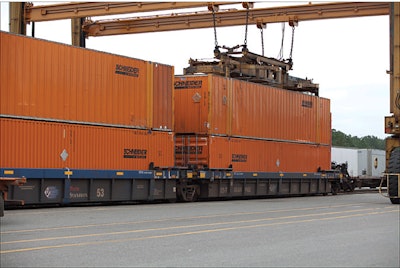 Schneider National works with customers to specify that high-value loads be placed on the bottom position of the well of a double-stack rail car to prevent thieves from opening container doors.
Schneider National works with customers to specify that high-value loads be placed on the bottom position of the well of a double-stack rail car to prevent thieves from opening container doors.Schneider National employs a multilayered approach with high-tech and low-tech security measures. Before a sensitive load is tendered to a driver, he receives a briefing on what freight is being hauled and the security measures required.
“We find it’s better to have our drivers be informed and be part of the solution rather than treat them as part of the problem,” says Fountain. “We absolutely expect our drivers to be key partners in the process.” Schneider National solicits suggestions from drivers on a monthly basis on how to improve security procedures.
The company updates drivers on a weekly basis on theft incidents at specific truckstops and helps them plan routes to avoid problem areas. It also requires drivers hauling sensitive freight to have a full tank of fuel prior to receiving a load to avoid stopping within the first 250 miles.
Drivers also are expected to inspect the load at each stop and communicate with dispatch. Schneider National uses trailer-tracking technology that sends alerts when a trailer door has been opened or otherwise compromised. The company even works with customers who want to imbed covert load-tracking technology and is able to detect when the freight itself has been disturbed.
When possible, Schneider National uses team drivers to haul high-value loads to reduce stopping at truckstops. The company also established a nationwide network of 35 drop-lot facilities with added security technologies to ensure high-value freight is safe when not in motion.
For freight moved via rail, Schneider National works with customers to specify that high-value loads be placed on the bottom position of the well of a double-stack rail car to prevent thieves from opening container doors.
“We have tried to target things that are low-tech, easily executable and low-cost – but have a solid return to us,” says Fountain.
CCJ Innovators profiles carriers and fleets that have found innovative ways to overcome trucking’s challenges. If you know a carrier that has displayed innovation, contact Jeff Crissey at [email protected] or 800-633-5953.



